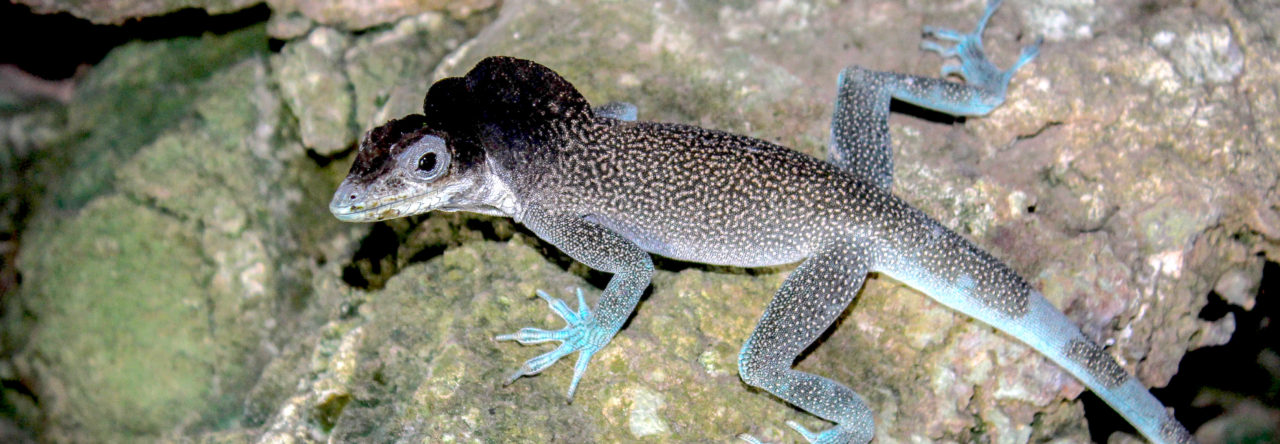
LIke all the anoles in our study, a considerable fraction of A. equestris’ diet was derived from the flow of allochthonous resources into its habitat.

A. sagrei, probably the most common vertebrate in Florida perch low on trees making occasional forays to the ground to feed.
The ecological importance of small, terrestrial insectivores such as litter frogs and small geckos is a topic that I’ve been curious about for years. While my dissertation research does not include anything about it, I am still quite curious about how these small, diverse and abundant vertebrates fit into ecosystems. Anoles possess all of the attributes that seem to predispose them to strong interactions and soon after arriving in Miami to begin my Ph.D., I decided to launch a small, side-project using tried-and-true food web tools, stable isotopes and gut content analysis to try to illustrate if and how these small, rather inconspicuous predators might affect ecosystem structure and function. The results of this study were just published online in Functional Ecology.
Basically, we found that anoles couple adjacent food webs by consuming insects that move across habitat boundaries. While food web linkages are a potentially important ecological dynamic and our study yielded some unique findings, there are other bits of information for those more generally interested in anole biology. Therefore, I’ve decided to break this post into two parts. Part 1 deals with our primary findings and contextualizes them within current understanding of food web ecology linkages. It’s sort of a geeky treatment of the subject. Part 2 will illustrate some of the other data that we’ve collected that were not dealt with explicitly in the paper that will be of interest to, I suspect, AA readers.
Bidirectional trophic linkages couple canopy and understory food webs
Sean T. Giery,Nathan P. Lemoine, Caroline M. Hammerschlag-Peyer, Robin N. Abbey-Lee, and Craig A. Layman
1. Cross-system resource flux is a fundamental component of ecological systems. Allochthonous material flows generate trophic linkages between adjacent food webs, thereby affecting community structure and stability in recipient systems.
2. We investigated cross-habitat trophic linkages between canopy and understory food webs in a terrestrial, wooded, ecosystem in South Florida, USA. The focal community consisted of three species of Anolis lizards and their prey. We described interspecific differences among Anolis species in the strength and routing of these cross-habitat flows using stable isotope analysis, stomach content analysis, and habitat use data.
3. All three Anolis species in this study consumed different prey, and occupied vertically distinct arboreal habitats. Despite these differences, carbon isotope and stomach content analysis revealed strong integration with understory and canopy food webs for all Anolis species. Modes of resource flux contributing to the observed cross-habitat trophic linkages included prey movement and the gravity-driven transport of detritus.
4. Our study shows that terrestrial systems are linked by considerable bidirectional cross-system resource flux. Our results also suggest that considering species-specific interactions between predator and prey are necessary to fully understand the diversity of material and energy flows between spatially separated habitats.

The study system was dominated by St. Augustine grass and isolated Ficus trees.
Some basics – The community was composed of four anole species, Anolis sagrei, A. distichus, A. carolinensis*, and A. equestris. The study site was recently featured in AA. Generally, the purpose of the study was to describe variation among species in resource use using stomach contents, habitat use, and stable isotope analysis. But based on some initial observations and a bit of stable isotope data, we had considered that there might be a role for anoles in ecosystems via linking spatially distinct food webs. That is, anole diets might be sourced, in part, by primary production originating outside their respective microhabitats. Basically, we knew that anoles occupy distinct arboreal habitats, but when we examined the stomach contents of each, we found that some prey were from habitats spatially distinct from the ones used by each anole species (e.g., How do terrestrial grasshoppers get inside a canopy giant anole such as A. equestris?),which spawned a more in-depth investigation. Additionally, some initial stable isotope data strongly supported the same interpretation – that is, anole diets might be at least partially derived from allochthonous resources.
Read More




















